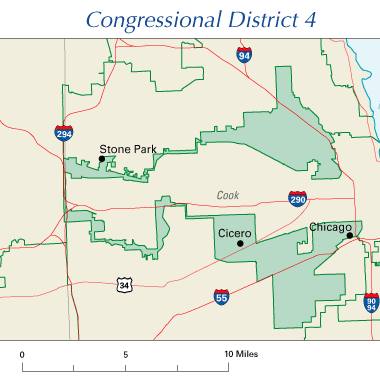OK, So What’s The Problem?
If you missed last week’s installment, take a look, as it summarizes how redistricting in Virginia works. If you’re too busy, the basics on your author: In 2007 I was asked to run a new non-profit effort to reform Virginia’s redistricting system. A group of moderate business leaders had decided to raise funds for the effort. For the next 7 months, I shuttled between my Arlington home and Richmond as Executive Director of the Virginia Redistricting Coalition. I’ll use this series to pose a few basic questions about redistricting reform and explore the philosophical and practical implications of such an effort. As a warning up front, I am not a lawyer. So while I am fairly well-versed in the relevant concepts, don’t take my word for gospel on the legal precepts. I’m also going to assume you’re familiar with the basics: gerrymandering, the Civil Rights Act of 64, reapportionment generally, and the current state of the ‘science’ of partisan redistricting.
Partisan redistricting – is it really a problem? First principles –  what is the problem with partisan redistricting? Per Baker v. Carr and later Gray v. Sanders, modern partisan redistricting efforts do not endanger the effective power of an individual’s vote, nor do they dilute the ability of a constitutionally protected class to achieve representation (post-Voting Rights Act of 65). So we must at least consider whether or not drawing district lines for partisan gain is either constitutionally (or morally) acceptable. The constitutional question remains unsettled – a series of cases has yet to define a standard for determining if a partisan gerrymander is an equal protection violation. (See Vieth v. Jubelirer & Davis v. Bandemer – I’m not qualified to belabor the details.) Without settled case law, this leaves us to ask if there is a public interest in removing partisan influence from redistricting.
what is the problem with partisan redistricting? Per Baker v. Carr and later Gray v. Sanders, modern partisan redistricting efforts do not endanger the effective power of an individual’s vote, nor do they dilute the ability of a constitutionally protected class to achieve representation (post-Voting Rights Act of 65). So we must at least consider whether or not drawing district lines for partisan gain is either constitutionally (or morally) acceptable. The constitutional question remains unsettled – a series of cases has yet to define a standard for determining if a partisan gerrymander is an equal protection violation. (See Vieth v. Jubelirer & Davis v. Bandemer – I’m not qualified to belabor the details.) Without settled case law, this leaves us to ask if there is a public interest in removing partisan influence from redistricting.
What’s your goal? – Representativeness? Hah! The most oft-cited reason for reforming the district-drawing process is a two-part argument that usually goes something like this:
 “The legislature doesn’t represent what people want because there are too many republicans/democrats/socialists/rastafarians in the legislature. All those republicans/democrats/socialists/rastafarians have destroyed competition so the other party has no chance of winning.”
“The legislature doesn’t represent what people want because there are too many republicans/democrats/socialists/rastafarians in the legislature. All those republicans/democrats/socialists/rastafarians have destroyed competition so the other party has no chance of winning.”
The assumptions of this argument reveal the biggest philosophical hurdle of redistricting reform: the tension between representativeness and competiveness. For many political observers, this is really an argument between individual representativeness and community representativeness and the above critique is a fundamentally liberal one.
Take the example of a heavily gerrymandered district. Upwards of 65% of the people in our hypothetical district are Democrats. They vote for Democrats and are represented by a Democratic member of Congress and Democratic state legislators. As individuals, their political preferences are relatively close to that of their elected representatives. This is the effect of partisan redistricting: The political views of my representative are close to my political views. In fact, the political views of the majority of voters in my district are quite close to the views of their representative.(The partisan minority of voters in my district? Well, they’re the minority and we live in a majoritarian democracy – screw ‘em.) Additionally, the strong party slant means that my district is not at all competitive in a general election.
Let’s take another example. Let’s say that a districts were drawn not to maximize local or individual representativeness, but to represent the state as a whole. This would give us a situation where the mean and distribution of representatives in the legislature are broadly reflective of the state. But in doing so, the average citizen’s views are going to be a bit farther from the views of their representative. In fact, the majority of voters in this district, as compared to our other example, are – on average – farther away from their representative’s views. Additionally, the lack of a party slant means that my district is quite competitive in a general election. (You can see some of these underlying concepts in Madison’s discussions of faction in a large republic in the Federalist papers.)
This is the real balance: Districts drawn to favor one party lead to uncompetitive districts with strong individual/local representativeness but poor statewide representativeness. Districts drawn for statewide representativeness lose individual representativeness but gain competitiveness. Put another way, the political preferences of the voters in a gerrymandered district cluster more closely around the views of their representative, resulting in a smaller standard deviation from the mean (their Rep). Yet this causes a corresponding increase in the standard deviation when you plot the representatives from across the state around the state’s mean (a statewide elected official).
If my math analogies don’t entirely make sense to you, don’t worry: We’ll cover the practical implications in part 3.
Always, politics: Politically-minded readers will likely see this individual vs. community representativeness question the same way I do: As a right-vs-left question as well. My experience has been that this issue is at the base of many Democrats’ support for redistricting reform and many Republicans opposition to it. Conservatives tend to value individual preferences over community goods, generally speaking. (Further reading: Moral Politics by George Lakoff.) You’ll find that, in practice, politically liberal and libertarian voters tend to support redistricting reform regardless of partisan affiliation.
Representation theory. All these questions of representativeness, closeness of views to that of our representative, etc., do raise important and fundamental questions about what the role of a representative is. There is more than one model of how a representative can do their job:
“I represent my voters.” The most basic option. Someone with this view sees his or her job as representing only those who voted for him/her in their election. So people who don’t vote, and people who didn’t vote for them, don’t figure into the representative’s thinking. Practically speaking, this is often called “Governing at 51%.” The most successful modern practitioner is probably Karl Rove circa 2004.
“I represent my district.” This representative holds a broader view of their job. This is easier in a moderate, or less polarized, district, since that makes it easier to please both political persuasions. Most representatives I know will say that this is what they do, but many of them are more likely to actually live the first…. After all, reelection is the priority.
“I represent my party.” No one ever says this. But there isn’t a politician in the world who isn’t worried about protecting their standing in their party, not to mention their liberal/conservative flank against a primary challenge.
In the real world, in practice, you’ll usually see a mix between #1 and #3 or #2 and #3. It depends on the ideological persuasion of the member and the partisan makeup of their district. But these are important differences to keep in mind when dealing with the practical side of the issue – how to pass legislation in support of redistricting reform.
Next, Part 3: Less theory, more practice. Party primaries, polarization, and the real reason reform is in the public interest.
David Solimini is a political strategist and the owner of ADco Creative Productions. 2007-2008 he was the Executive Director of the Virginia Redistricting Coalition. He is currently the Media Director of the Truman National Security Project. Solimini holds a BA from the College of William & Mary. He can be reached at dsolimini@gmail.com.
Permalink: http://stateofelections.pages.wm.edu/2009/11/23/redistricting-reform-part-2/
[…] is a bad thing. It’s been about a month, so it may be worthwhile to go back and read the last few in the […]